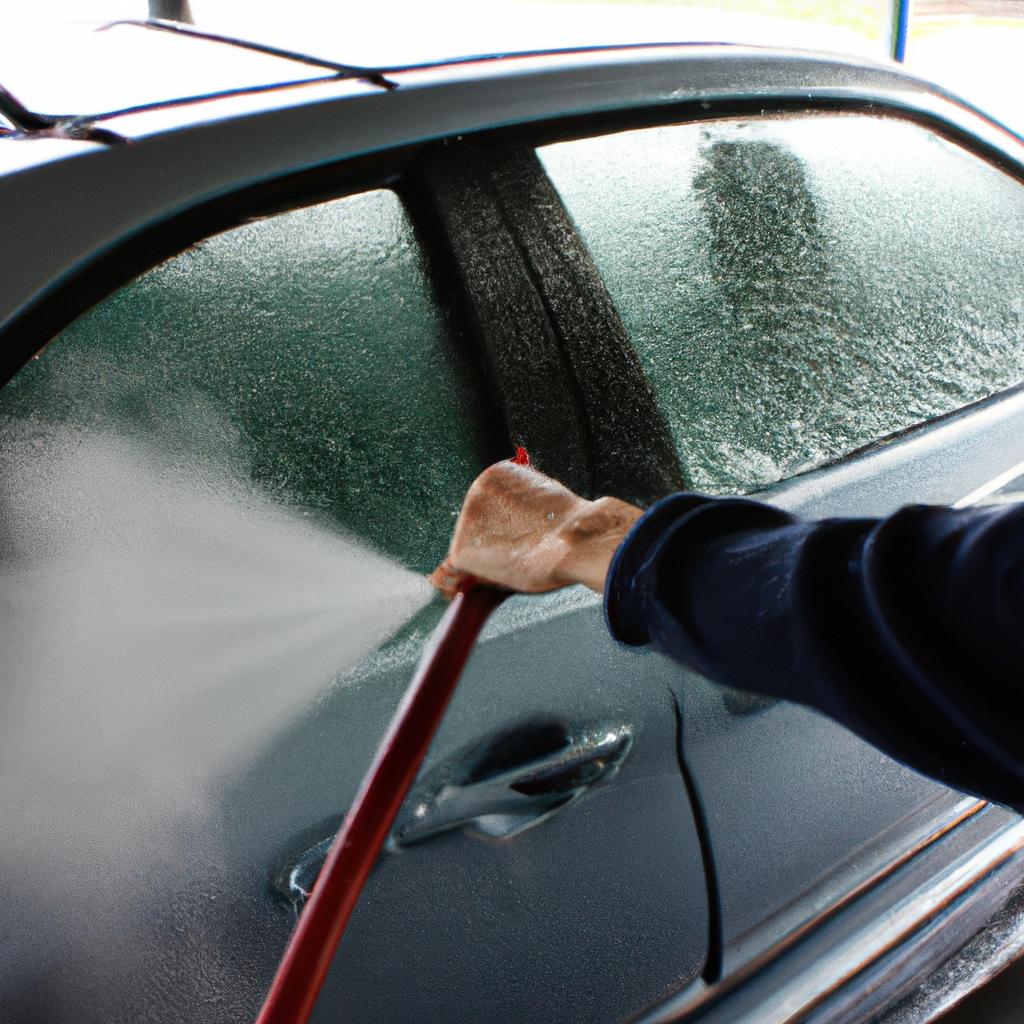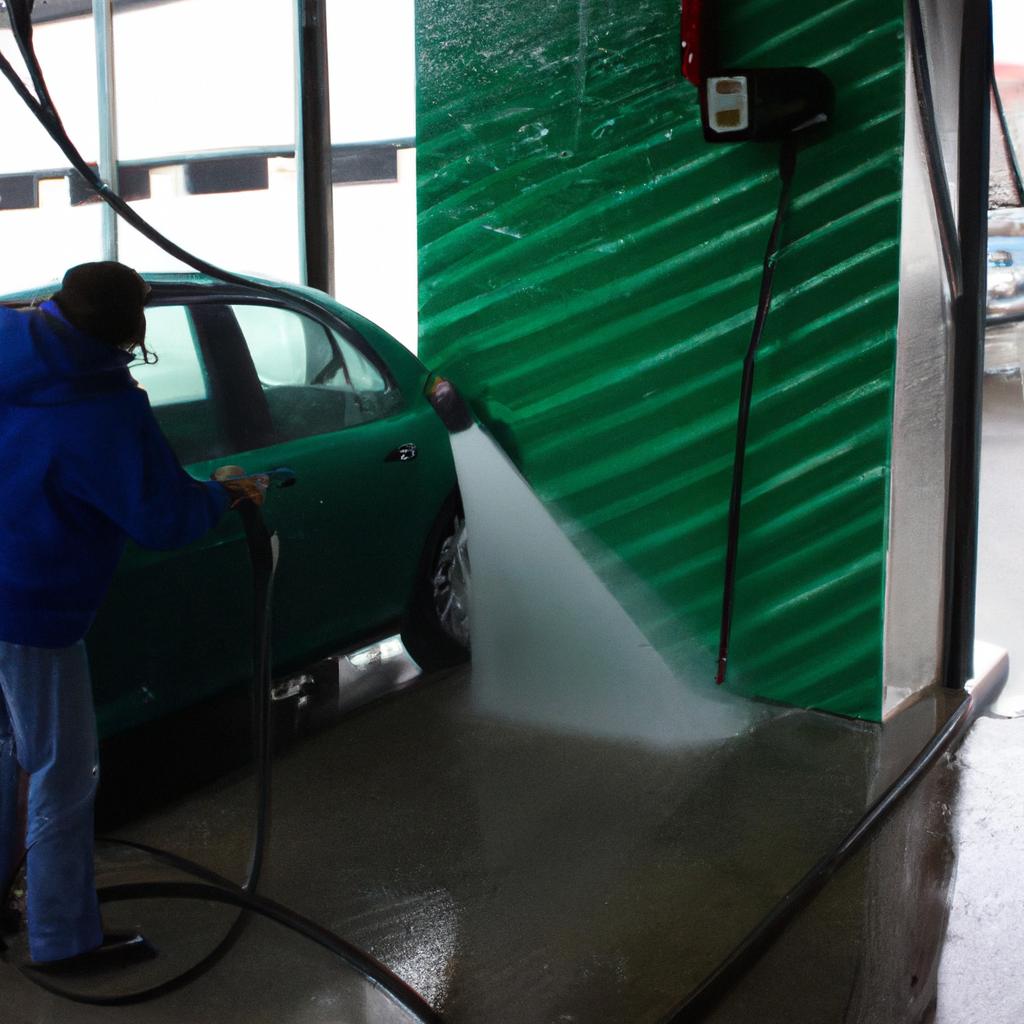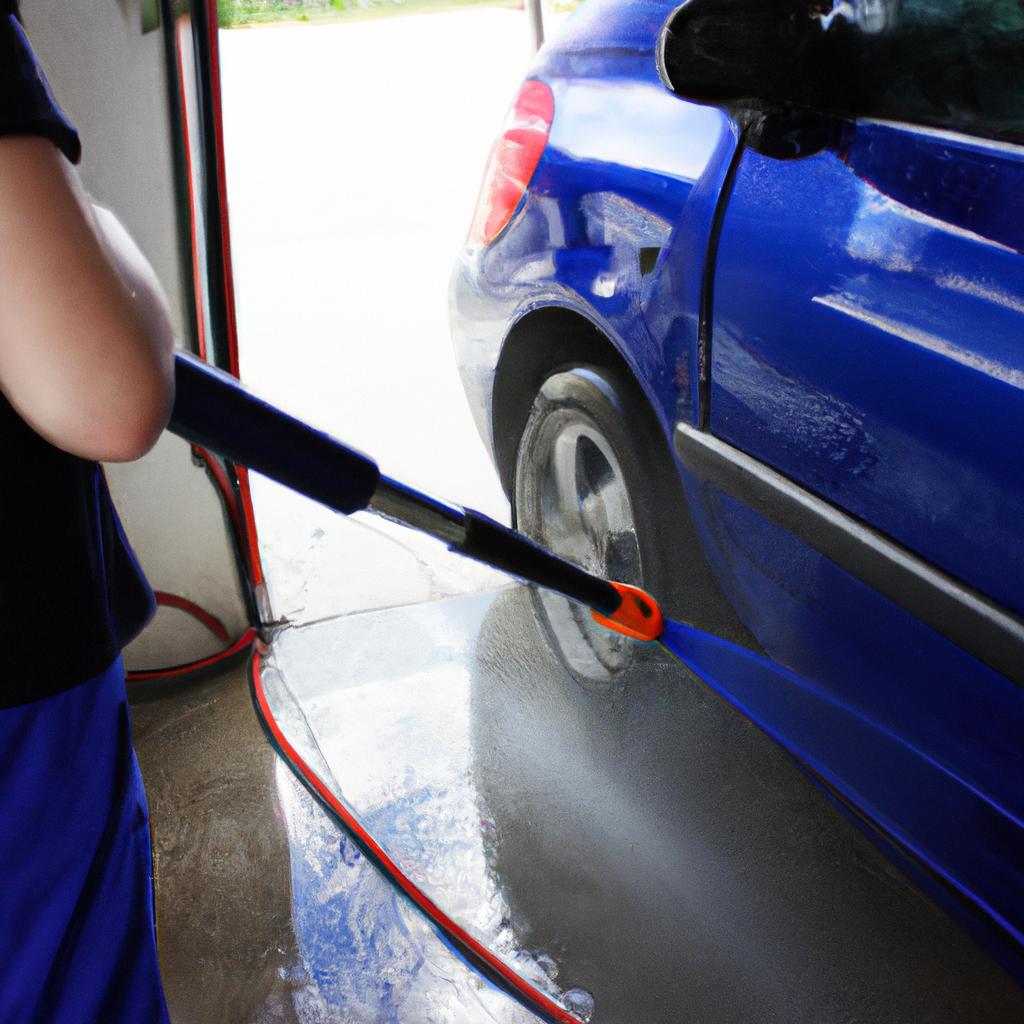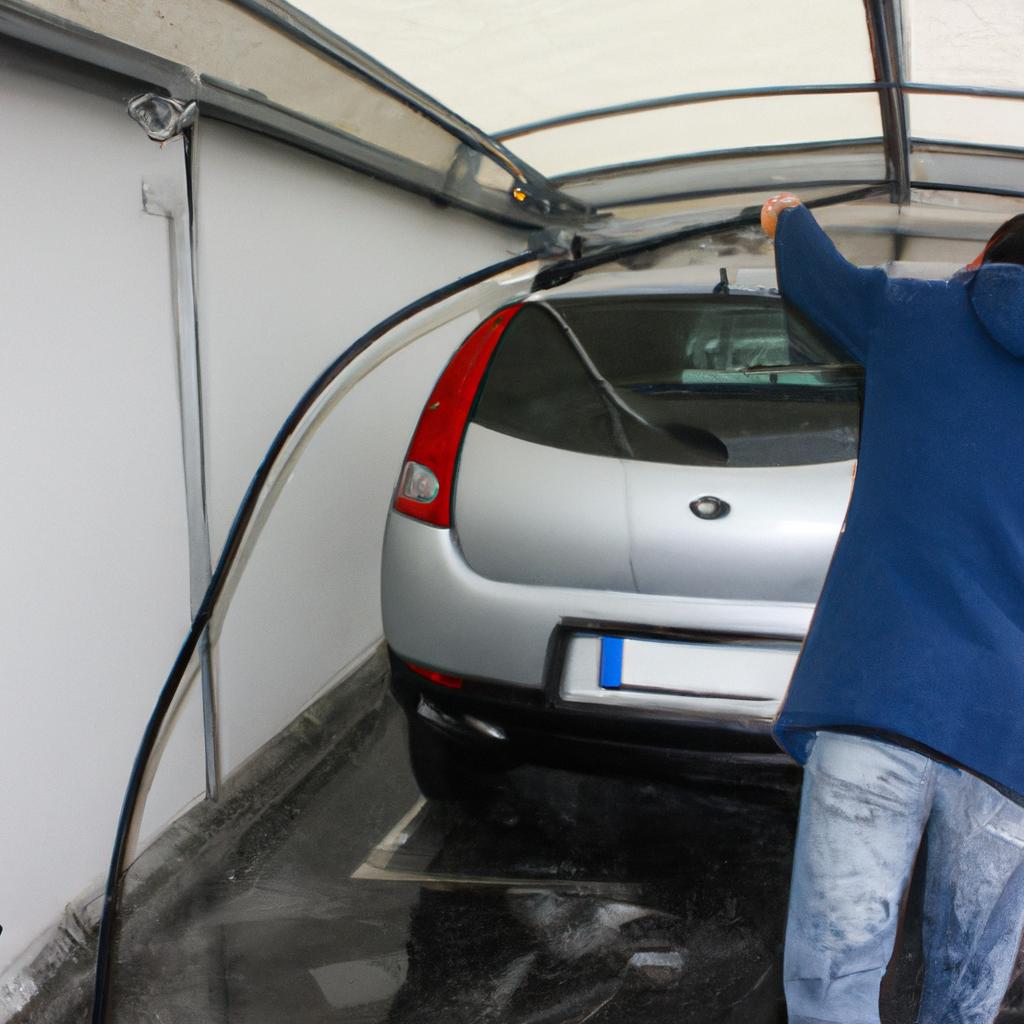Car washing is an essential part of vehicle maintenance, not only for aesthetic purposes but also for preserving the longevity and performance of the car. Among the various techniques available in the market, touchless car wash systems have gained popularity due to their efficient cleaning capabilities without causing any damage or scratches. One crucial component that contributes significantly to a thorough clean is the undercarriage wash. By targeting hard-to-reach areas underneath the vehicle, this process ensures the removal of dirt, debris, and corrosive substances that can compromise its structural integrity.
To comprehend the significance of undercarriage wash in touchless car wash systems, consider a hypothetical scenario where two cars are subjected to varying levels of cleanliness over several years. Car A undergoes regular touchless car washes with comprehensive undercarriage cleansing as part of its routine maintenance schedule. On the other hand, Car B receives conventional manual washing methods that neglect proper attention to its undercarriage region. Over time, it becomes evident that Car A maintains better performance and exhibits fewer signs of corrosion or rusting compared to Car B. This example highlights how an effective undercarriage wash can play a pivotal role in ensuring optimal cleanliness and protection for vehicles in touchless car wash systems.
Importance of Undercarriage Maintenance
Imagine driving your car through muddy terrain, only to find out later that the undercarriage has become caked in dirt and grime. Not only does this impact the appearance of your vehicle, but it can also lead to serious consequences for its overall performance and longevity. Regular maintenance of the undercarriage is crucial to ensure optimal functioning and extend the lifespan of your car.
One key reason why undercarriage maintenance is essential is to prevent rust and corrosion. The undercarriage is exposed to various environmental elements such as rain, snow, salt, and road debris that can cause metal components to deteriorate over time. For instance, a case study conducted by Car Magazine found that vehicles driven in areas with heavy road salt usage had significantly higher rates of corrosion on their undercarriages compared to those in regions where salt was not used extensively.
To emphasize the importance of undercarriage maintenance further, consider the following bullet points:
- Rust and corrosion can weaken structural integrity.
- Accumulated debris may obstruct vital parts like suspension systems.
- Neglected maintenance increases the risk of costly repairs or part replacements.
- Regular cleaning helps maintain resale value.
| Traditional Cleaning Methods | Touchless Car Wash |
|---|---|
| Limited access to tight spaces underneath | Thoroughly cleans all nooks and crannies |
| Time-consuming process | Quick and efficient |
| Manual labor required | Automated system reduces human error |
| Inadequate removal of tough stains | Uses powerful chemicals for deep cleaning |
By incorporating a touchless undercarriage wash into your car maintenance routine, you not only enhance the appearance of your vehicle but also ensure its long-term performance and durability. This method eliminates the need for manual labor while effectively removing dirt and grime from hard-to-reach areas.
Transitioning to the next section about “Benefits of a Touch-Free Undercarriage Wash,” it becomes evident that this modern approach offers numerous advantages over traditional cleaning methods.
Benefits of a Touch-Free Undercarriage Wash
Having understood the significance of undercarriage maintenance, let us now explore the numerous benefits that a touch-free undercarriage wash can offer. To illustrate this further, consider the following hypothetical scenario:
Example:
Imagine you live in an area with harsh winters where road salt is heavily used to melt ice and snow. Over time, this salt accumulates underneath your vehicle, leading to corrosion and damage to vital components such as the exhaust system, suspension, and brake lines.
Benefits of a Touch-Free Undercarriage Wash:
-
Enhanced vehicle longevity: Regularly subjecting your vehicle to a touch-free undercarriage wash helps remove corrosive substances like road salt, mud, and debris that accumulate on the underside. By preventing these contaminants from lingering and causing damage over time, you significantly increase your car’s lifespan.
-
Improved safety: A clean undercarriage ensures optimal functionality of essential parts such as brakes and suspension systems. By eliminating dirt build-up that can impede their performance, you enhance overall driving safety.
-
Cost-effective preventive measure: Investing in touch-free undercarriage washes is considerably more affordable than repairing or replacing corroded components later on. Implementing this preventative measure saves you money by addressing potential issues before they escalate into costly repairs.
-
Environmental preservation: Given its high-pressure water-based cleaning technique, touch-free undercarriage washes are eco-friendly compared to traditional methods involving chemicals or brushes. This method minimizes chemical runoff while effectively removing harmful substances without damaging the environment.
Table (markdown format):
| Benefits of a Touch-Free Undercarriage Wash |
|---|
| Enhanced vehicle longevity |
| Improved safety |
| Cost-effective preventive measure |
| Environmental preservation |
Understanding the benefits of a touch-free undercarriage wash paves the way for exploring how these washes work. By comprehending their underlying mechanisms, you can make informed decisions about incorporating this maintenance technique into your car care routine.
How Undercarriage Washes Work
Imagine you have just purchased a brand new car. It’s shiny, sleek, and a symbol of your hard work and success. You want to keep it looking pristine for as long as possible. One way to achieve this is through regular undercarriage washes. These touch-free cleans not only enhance the appearance of your vehicle but also provide several other benefits.
First and foremost, an undercarriage wash helps remove dirt, salt, mud, and other debris that can accumulate on the underside of your car. This is particularly important if you live in an area with harsh winters or near coastal regions where road salt or sea spray are common. By eliminating these contaminants, you reduce the risk of rust formation and corrosion damage to vital components such as brake lines and exhaust systems.
Additionally, a touchless undercarriage wash promotes better overall vehicle hygiene. The accumulation of dirt and grime under your car can harbor bacteria, mold, and even pests like rodents. By regularly cleaning the undercarriage, you prevent these unwanted guests from finding their way into your vehicle’s interior.
Moreover, an undercarriage wash contributes to improved safety while driving. When mud or debris accumulates on the underside of your car, it can affect its stability and traction on the road. By removing these substances regularly, you ensure optimal contact between your tires and the road surface, reducing the risk of accidents caused by reduced grip.
- Protects against rust formation
- Enhances cleanliness for a healthier environment
- Improves safety through better tire-to-road contact
- Preserves resale value by preventing avoidable damage
Furthermore, let us explore how different parts of your vehicle benefit from an effective undercarriage wash using this three-column table:
| Vehicle Part | Benefits of Undercarriage Wash |
|---|---|
| Brake Lines | Prevents rust and corrosion |
| Exhaust System | Extends lifespan by reducing corrosive damage |
| Suspension | Preserves optimal performance |
As you can see, these washes are not just about keeping your car clean; they play a crucial role in maintaining its overall functionality and longevity.
Transitioning into the subsequent section on “Preventing Rust and Corrosion,” it is vital to note that undercarriage washes are only one step toward achieving this goal. By exploring further preventive measures, we can ensure your vehicle stays protected from the damaging effects of rust and corrosion for years to come.
Preventing Rust and Corrosion
Understanding how undercarriage washes work is crucial in comprehending their impact on preventing rust and corrosion. Now, let’s delve into the importance of undercarriage washes for safeguarding your vehicle against these damaging effects.
To illustrate the significance of undercarriage washes in preventing rust and corrosion, consider the following scenario. Imagine two cars exposed to identical environmental conditions over time—a car that regularly undergoes thorough touchless car washes with an emphasis on undercarriage cleaning, and another car that only receives surface-level washing. After several years, you will likely observe visible differences between the two vehicles regarding rust formation and overall deterioration.
Undercarriages are particularly vulnerable areas prone to accumulating dirt, debris, road salt, and other corrosive substances during daily use. Regularly subjecting your vehicle to an undercarriage wash offers numerous benefits:
- Removal of harmful substances: An effective undercarriage wash removes accumulated dirt, mud, salt residue, and other potentially corrosive materials from hard-to-reach areas beneath your vehicle.
- Protection against rust formation: By eliminating highly corrosive agents trapped within the underbody components, such as brake dust or road salt deposits, you can significantly reduce the risk of rust formation.
- Preservation of structural integrity: Routinely cleaning the undercarriage prevents damage caused by long-term exposure to corrosive elements. This preservation ensures that vital components like suspension parts remain intact and functional.
- Enhanced resale value: A well-maintained vehicle with minimal signs of rust or corrosion holds greater appeal among potential buyers compared to one showing severe degradation.
The table below highlights some common types of corrosion and their potential consequences:
| Type of Corrosion | Potential Consequences |
|---|---|
| Surface Rust | Superficial paint damage |
| Pitting Corrosion | Irregular surface texture, reduced strength |
| Crevice Corrosion | Structural integrity compromise |
| Galvanic Corrosion | Accelerated deterioration |
Incorporating regular undercarriage washes into your car care routine is a proactive measure to protect against rust and corrosion. By doing so, you can increase the lifespan of vehicle components while ensuring its overall appearance remains appealing.
Understanding how undercarriage washes prevent rust and corrosion lays the foundation for exploring another crucial aspect: increasing the lifespan of vehicle components.
Increasing the Lifespan of Vehicle Components
Picture this scenario: You’ve just purchased a brand new car, shiny and gleaming in the sun. It’s your pride and joy, and you want to ensure it stays that way for as long as possible. One of the biggest threats to the longevity of your vehicle is rust and corrosion. Luckily, there are steps you can take to prevent these damaging effects.
Firstly, regular cleaning plays a crucial role in preventing rust and corrosion from taking hold. While many car owners focus on washing the exterior surfaces, they often neglect one vital area – the undercarriage. The underside of your car is particularly vulnerable to rust due to exposure to various elements such as road salt, mud, dirt, and moisture. By incorporating an undercarriage wash into your routine maintenance schedule, you can effectively remove these corrosive substances before they cause significant damage.
To highlight the importance of undercarriage washes in preventing rust and corrosion, consider a hypothetical case study involving two vehicles exposed to similar conditions over time:
Vehicle A undergoes regular undercarriage washes as part of its maintenance routine.
Vehicle B does not receive any undercarriage washes.
After several years of use in areas with harsh winters where road salt is commonly applied, Vehicle A shows minimal signs of rust or corrosion compared to Vehicle B.
This example demonstrates how implementing an undercarriage wash regimen can significantly increase the lifespan of your vehicle by protecting it against rust and corrosion.
Here are four key reasons why undercarriage washes are essential for preventing rust and corrosion:
- Removes corrosive substances: An undercarriage wash effectively removes road salts, mud, dirt, and other corrosive materials that accumulate underneath your vehicle.
- Minimizes water retention: By thoroughly rinsing off the undercarriage during a touchless car wash process, excess water is removed promptly. This reduces prolonged exposure to moisture which helps prevent rust formation.
- Preserves protective coatings: Many vehicles have factory-installed undercoating or additional protective coatings applied to the undercarriage. Regular washes help maintain these protective layers, ensuring they continue to provide an effective barrier against rust and corrosion.
- Extends component lifespan: By preventing rust and corrosion from developing on critical components such as brake lines, fuel lines, and suspension parts, undercarriage washes contribute to extending their overall lifespan.
To further emphasize the benefits of incorporating undercarriage washes into your car care routine, consider the following table:
| Benefit | Undercarriage Washed | No Undercarriage Wash |
|---|---|---|
| Reduced maintenance | :white_check_mark: | |
| costs | ||
| Enhanced vehicle | :white_check_mark: | |
| appearance | ||
| Improved resale value | :white_check_mark: | |
| Peace of mind | :white_check_mark: |
By investing in regular undercarriage washes, you can enjoy a range of benefits that not only protect your vehicle but also offer peace of mind and enhance its long-term value.
Transitioning seamlessly into our next section about “Choosing the Right Undercarriage Wash System,” it’s important to understand how various factors come into play when considering which system is best suited for your needs.
Choosing the Right Undercarriage Wash System
Increasing the Lifespan of Vehicle Components through Undercarriage Wash
To understand the importance of undercarriage wash in extending the lifespan of vehicle components, let’s consider a hypothetical scenario. Imagine two cars with identical models and usage patterns: Car A receives regular undercarriage wash as part of its maintenance routine, while Car B does not. After three years, an inspection reveals that Car A has significantly fewer rust spots on its undercarriage compared to Car B. This example demonstrates how proper undercarriage cleaning can play a crucial role in preserving the longevity of vehicle components.
Undercarriages are exposed to various environmental factors such as dirt, road salt, debris, and corrosive chemicals. Over time, these elements accumulate and lead to corrosion and damage to critical parts like suspension systems, exhausts, fuel lines, brake lines, and frames. Regularly washing the undercarriage helps remove harmful substances before they cause deterioration or compromise functionality.
Here are some key benefits of incorporating undercarriage wash into your car maintenance routine:
- Prevention of Rust Formation: Rust is one of the most common issues faced by vehicles due to exposure to moisture and oxidation processes. Cleaning the undercarriage eliminates trapped water and prevents rust formation on metal surfaces.
- Protection against Corrosion: The accumulation of road salt during winter months can accelerate corrosion rates if left unattended. By performing regular undercarriage washes, you effectively remove residual salts that could attack metal components.
- Enhanced Safety: Neglecting undercarriage cleanliness increases the risk of structural weaknesses developing over time. Ensuring a clean underbody reduces this risk and promotes safer driving conditions.
- Longevity of Vehicle Components: Continuous exposure to contaminants can weaken essential parts over time. By implementing regular undercarriage washes, you protect vital components from premature wear and tear.
Consider the following table showcasing potential risks associated with neglecting undercarriage cleanliness:
| Risk | Consequence |
|---|---|
| Rust Formation | Weakens structural integrity and affects resale value |
| Corrosion | Damages critical components, leading to expensive repairs |
| Compromised Safety | Increases the risk of accidents |
| Reduced Component Life | Shortens the lifespan of various vehicle parts |
In summary, incorporating undercarriage wash into your car maintenance routine is essential for increasing the lifespan of vehicle components. By regularly removing harmful substances that accumulate in the underbody, you can prevent rust formation, protect against corrosion, enhance safety, and ensure a longer life span for critical parts. Remember, neglecting this aspect may lead to costly repairs or even compromise your safety on the road.
 Shine Time Car Wash
Shine Time Car Wash



